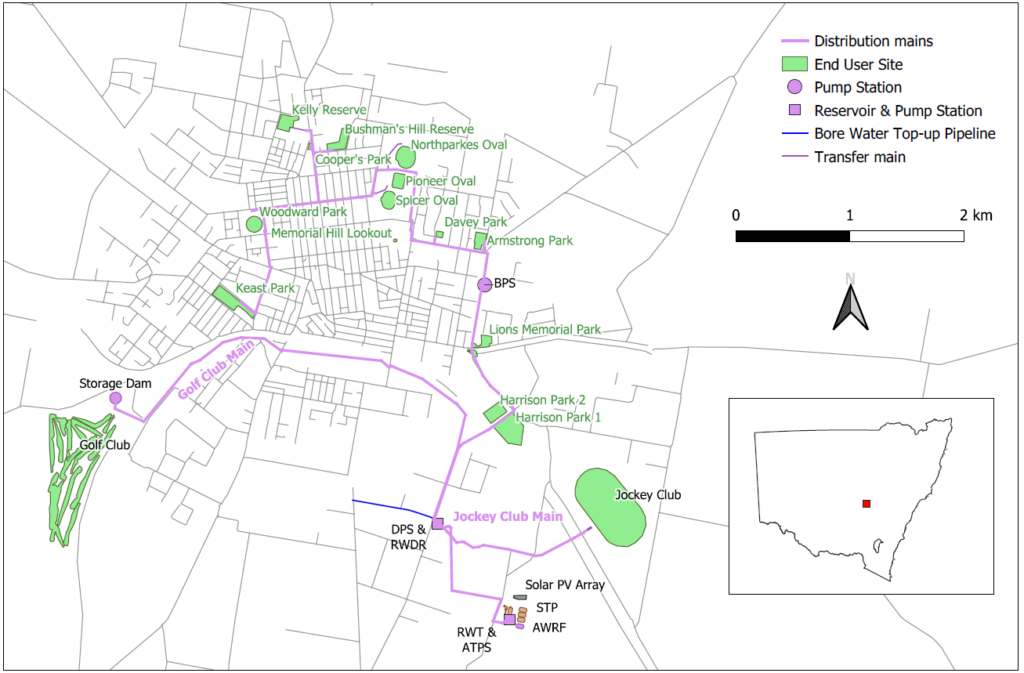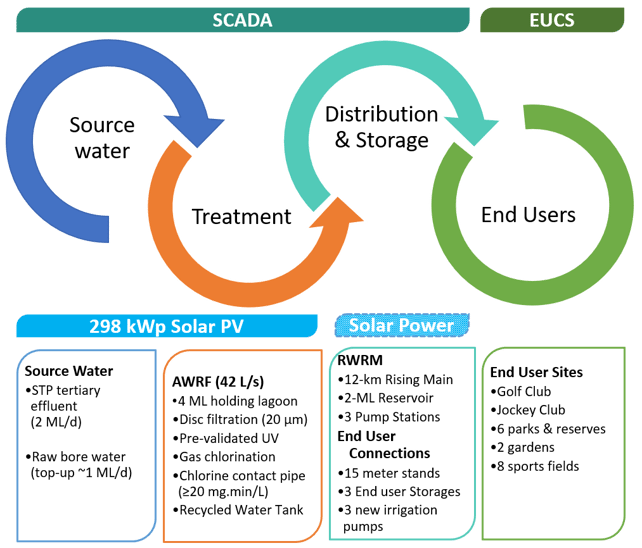Recycled water for a greener Parkes

Central West NSW town’s scheme responds to droughts and water security concerns
DOWNLOAD THE PAPER
ABSTRACT
In the face of severe droughts and associated water scarcity, Parkes Shire Council, a local government and water utility in Central West NSW, established a pioneering Recycled Water Scheme (RWS) for the irrigation of playing fields and other open spaces within and around the Parkes urban area. The Parkes RWS comprises a fit-for-purpose and resource-efficient Advanced Water Recycling Facility that achieves pathogen log reduction values (LRVs) to suit unrestricted municipal irrigation, and automatically diverts and recirculates reclaimed water that does not meet specification. The distribution system comprises 12 km of new pipeline, three state-of-the-art pump stations and a 2 ML reservoir, which can also receive raw water from the Parkes borefield to make up shortfalls in the supply-demand balance. While the necessary LRVs are met by treatment, an IoT-enabled web-based End User Control System provides additional non-treatment barriers by preventing irrigation outside night-time scheduling or during unfavourable weather. The Control System also promotes water efficiency through the management of water allocations and by identifying and notifying users of potential leaks. This paper presents the Parkes RWS as a case study of water infrastructure project founded on with complementary water security and sustainability imperatives that has also achieved a wide array of additional short- and long-term sustainability outcomes through delivery. It illustrates the complexity and breadth of the task of instituting a recycled water supply scheme and details the outcomes and lessons learnt from the process. The insights may assist other regional water utilities looking to diversify their water supplies.
KEYWORDS: Water Security, Recycled Water, Community Resilience, Sustainability, Climate change, Drought
INTRODUCTION
In late 2019, Parkes Shire Council (PSC) successfully commissioned its Recycled Water Scheme - a project fifteen years in the making and delivered together with a raft of water infrastructure projects that has shown Parkes to be a leader in water management in regional NSW. The new alternative water source is predicated on shoring up water security by providing a local, climate resilient water source that can maintain green spaces in times of drought to sustain community health and wellbeing. A product of long-term integrated water cycle management (IWCM) planning, the as-built Scheme comprises a resource-efficient, fit-for-purpose Advanced Water Recycling Facility (AWRF), a 12-km Recycled Water Rising Main (RWRM), three state-of-the-art pump stations and a 2 ML distribution reservoir. The sixteen end user sites pictured in Figure 1 are connected to the Scheme via smart meter stands linked to a unique IoT-enabled web-based End User Control System (EUCS) designed to encourage water conservation, manage water allocations and provide non-treatment barriers for further protection of public health. An offtake from the drinking water supply feeds raw bore water into the distribution reservoir, which makes up seasonal shortfalls in AWRF yield and provides surety of supply.
The RWS was conceived in light of community expectations around responsible water resource management, in particular the capture and beneficial reuse of wastewater for the dual benefit of water conservation and reduced environmental discharges. In keeping water in circulation for a second use, the Scheme will also deliver significant operational energy savings by reducing the need to pump raw water from Parkes’ distant water sources. Nevertheless in recognition of potential community sensitivity to the ‘yuck factor’ often attached to recycled water, PSC made sure that the strong public health focus that was adopted in the design of the Scheme was reflected in a concerted community engagement and communications effort. And to ensure that the as-built infrastructure is robust, resilient and delivers its purported sustainability benefits, it has been subject to two climate change risk assessments and two sustainability ratings.
This paper outlines the background, scope and nature of the RWS project, illustrating the complexity and breadth of the task of instituting a new recycled water supply scheme. It also demonstrates how infrastructure projects can be driven by planning imperatives aligned to sustainability, and delivered in a manner that targets and prioritises both short-term construction and longer-term operational sustainability outcomes.
Figure 1 Map of the Parkes Recycled Water Scheme
BACKGROUND
The Parkes Recycled Water Scheme (RWS) was conceived in PSC's first Integrated Water Cycle Management (IWCM) strategy (JWP, 2005). Defined by a target of achieving 100% reuse of dry weather flows from the new Parkes sewage treatment plant (STP), water recycling was a key principle identified by the Community Project Reference Group that was involved in setting the IWCM agenda. This set the groundwork for an intensive planning process that examined a range of water recycling options, identified key features through stakeholder engagement, secured funding, and formulated an overarching delivery and operation strategy. As planning for the Scheme took shape, a suite of goals and objectives was established to inform the delivery of the Scheme. The primary goal was to strengthen Parkes' water security and drought resilience by providing an additional, climate-resilient water source, reducing demand for potable water, and addressing Parkes' remoteness from raw water sources. Additional project objectives included:
• Maintaining and improving community services and amenity by:
> ensuring green parks and sports fields through drought
> adopting innovative approaches to water service provision
• Providing economic stimulus to support population, business, employment and tourism growth
• Reducing the energy footprint of Parkes' water supply to guard against rises in power prices and reduce Council's greenhouse gas (GHG) emissions
The Issue - Water security, Drought and Community Amenity
While Parkes is geographically water-constrained, it is fortunate to have access to diverse water sources, comprising two surface water dams, a borefield within the Upper Lachlan Alluvium, and the Lachlan River. The river and borefield, however, are located over 30 km away and sit some 125 m lower in elevation, necessitating energy intensive (~800 kWh/ML) and costly pumping. Additionally all three sources are prone to yield reductions during drought. The vulnerability of the two surface water sources in particular was put in stark relief in 2019, with record low inflows significantly reducing yield from the dams, and putting a hold on all general security allocations and curtailing high security allocations from the Lachlan River. Recycled water offers not only an additional water source, but one that is local and resilient to yield reductions caused by drought and climate change.
The original reuse target and the form of water recycling may have shifted from the 2005 IWCM strategy, but the fundamental intent has remained true through the 2011 review of the IWCM (MWH, 2012) and the 2015 update (PSC, 2017a). But perhaps the most important project driver from the community’s, and thereby Council's perspective arises from the pivotal role that sporting activities plays in the identity, lifestyle, community wellbeing and economic sustenance of the town. The provision of a water supply that can sustain sports fields and other green spaces through drought and extreme heat has enormous direct and indirect benefits, including improved visual amenity, greater opportunity for outdoor social activities, increased sports participation. This helps to position Parkes as a desirable location to host sporting events, tournaments, and championships, and attracting associated tourism. The community’s awareness of such benefits meant that water recycling was a far less contentious issue in Parkes than it has been in other parts of Australia where community opposition has put and end to or at least stymied recycled water projects.
For PSC as a local water utility, the RWS provides an alternative, low-cost supply, offering a levelised cost which compares favourably to other supply-side options. It creates the opportunity to reuse water that has a large energy footprint through conveyance from afar, keeping it in the water cycle one stage longer. This reduces not only energy consumption, GHG emissions and costs, but also the pressure placed on Parkes' natural water resources. The establishment of the Scheme has also been opportunistic, founded upon an apparent positive pre-dispostion amongst the community in regards to recycled water and leveraging the recent upgrade to the Parkes Sewage Treatment Plant (STP).
APPROACH
Planning for the Parkes RWS was set in motion by the inclusion of a water recycling option in the preferred scenario arising from the 2005 IWCM strategy, which simply featured a chlorination facility, storage and a distribution ring main servicing public open space (POS). However, it was not until 2014 that more detailed studies were undertaken to examine different options for a water recycling scheme in Parkes. A technical, environmental and social options assessment (Fyfe and Turner, 2014) and an economic appraisal (AEC Group, 2014) examined business as usual, agricultural and industrial reuse options, and the POS ring main option. The 2015 IWCM Strategy progressed full triple bottom line assessments of three scenarios incorporating different forms of water recycling - agricultural reuse, advanced treatment with limited distribution and a full POS ring main - ultimately adopting the scenario with the POS ring main.
Delivery Strategy
In 2015 PSC was awarded a grant of $8.725M from the Australian Government National Stronger Regions Fund to support the construction of the RWS infrastructure. To guide the delivery and operation of the Scheme, Council developed a strategy which explained the primacy of and approach to managing water quality and public health risks, as well as outlining the purpose, features, design principles and operational considerations of each of the main Scheme components shown in Figure 2. PSC sought to make the most of insights gained from past recycled water projects. Hence the strategy drew heavily on the Making Better Recycled Water Investment Decisions series of papers authored by the Institute for Sustainable Futures (ISF, 2013a, 2013b, 2013c, 2013d). In addition to the technical aspects of the RWS, the Strategy addressed Scheme governance and administration, and provided a roadmap for project procurement. In recognition of the complexity of rolling out an entirely new water supply, the strategy divided the rollout of the RWS into three Phases, which encompassed both construction and operational milestones as described in Figure 3.
Water Quality
PSC was acutely aware of the public health risks associated with the RWS. The design and operational philosophy of the Scheme thus centred around the safe use of fit-for-purpose recycled water. It was determined early that the necessary water quality barriers for unrestricted municipal irrigation would be implemented through tertiary (AWRF) treatment rather than relying on the upstream sewage treatment process or end user controls. Table 1 compares the AWRF design log reduction values (LRVs) with the Australian Guidelines for Water Recycling (AGWR) (EPHC et al., 2006) target LRVs, along with additional LRVs that could be claimed from other barriers. presents the water quality objectives established for the AWRF process specification.
Community
In preparation for Scheme delivery, PSC consulted with other regional utilities in NSW that had recently instituted similar municipal irrigation schemes. This highlighted the need for proactive community engagement and communications to address potential oppositional or negative sentiment and perceptions that could jeopardise the project. A stand-alone community engagement strategy was devised, placing emphasis on instilling confidence and pride in the Scheme through regular and multi-modal outreach and bringing the community along every step of the delivery journey. With community health and wellbeing sitting at the heart of the intent behind the RWS, the strategy took its cues from the Parkes Shire 2030+ Community Strategic Plan (PSC, 2017). The attendant communications plan focussed on raising public awareness of the project and its benefits, reassuring and educating the community about changes to services and Council’s commitment to protecting public health, and keeping the community informed of construction milestones and impacts.
Figure 2 Parkes RWS components
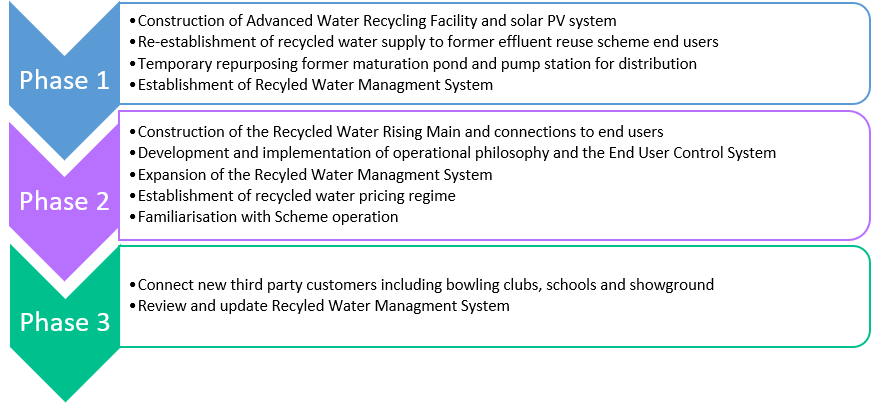 Figure 3 Parkes Recycled Water Scheme phasing
Figure 3 Parkes Recycled Water Scheme phasing
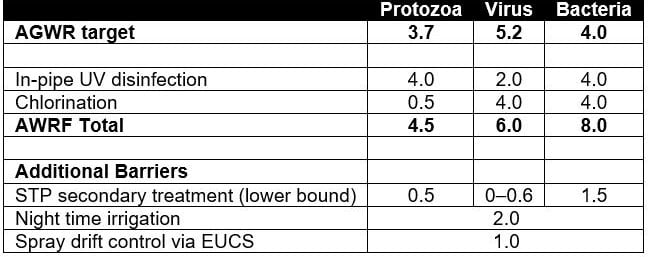 Table 1 Target, AWRF and other LRVs
Table 1 Target, AWRF and other LRVs
 Table 2 AWRF water quality objectives
Table 2 AWRF water quality objectives
Environment and Sustainability
The Scheme was procured as four separate detailed design and construct (DD&C) packages tied to the Scheme phasing – the AWRF under Phase 1, then then RWRM, end user connections and EUCS in Phase 2. The infrastructure packages were approved by Council as the determining authority under Part 5 of the Environmental Planning and Assessment Act 1979 following completion of exhaustive reviews of environmental factors that addressed construction and operational impacts (Gea Environmental, 2017; The Environmental Factor, 2018). The larger AWRF and RWRM DD&C projects have been subject to infrastructure sustainability ratings with the Infrastructure Sustainability Council of Australia (ISCA) in order to provide third party recognition of PSC’s approach to sustainable development, set a stretch target for the project team to work towards, and challenge contractors to prioritise sustainability outcomes (Fyfe et al., 2018).
Activities
Balancing Supply and Demand
Underpinning the Scheme’s development was the characterisation of the supply-demand balance, which formed the basis for the design of all components from treatment through to distribution and consumption of the recycled water. This involved monitoring and modelling of sewage inflows, recycled water yield and bore water availability, and the formulation of a soil moisture balance irrigation demand model, granular irrigation schedules based on detailed end user site data, and a dynamic system water balance model. Figure 4 illustrates the Scheme supply-demand balance, comparing theoretical average monthly irrigation demand by end user site (shown in columns) against AWRF and bore water supply modelled to meet actual irrigation schedules. Discrepancies between supply and demand sit well within one standard deviation of total demand in each month.
Water Quality Risk Assessment and Mitigation
The assessment of water quality risks was also foundational to the design of the Scheme and continues to inform its operation. The AWRF was the main focus of a risk assessment conducted in Phase 1, which examined the suitability and uncertainties of the treatment barriers and associated CCPs (Contos and Wilson, 2017). Despite being well-understood following almost two decades of treated effluent supply to the Phase 1 customers, end use risks were re-visited in the context of the new grade of recycled water. As delivery of Phase 2 of the Scheme kicked off, a second water quality risk assessment was undertaken to examine the additional hazards presented by distributing the recycled water to a broader end user base (Parsons et al., 2019).
With distribution entering the urban area, cross connections with the potable supply and irrigation overspray, spray drift, ponding and runoff were identified as a high risks to public and environmental health. A full inventory of potential cross connection points and exposure hazards was developed to better characterise the risks, which involved inspections of sprinkler systems and irrigation areas and their proximity to amenities and residences, operator consultation and field observations of overspray and spray drift in windy conditions. Then as part of the end user connections design, a detailed site audit of existing and potential connections between irrigation systems and other potable reticulation was prepared. Cross connection elimination measures were fed into the design report and drawings, and a register maintained to guide and record follow-up checks. Back-pressure was also checked at each site once all connections were completed. Lastly, an assessment quantifying the exposure risks was conducted on the end user sites that had been identified as having overspray issues affecting public facilities. The study found that the the low exposure levels to impacted buildings, picnic tables, benches and BBQs did not necessitate reconfiguring the irrigation or relocating the facilities.
 Figure 4 RWS Supply-demand balance
Figure 4 RWS Supply-demand balance
Environmental risks were also addressed in water quality design and assessment. Modelling was undertaken using the MEDLI software package to examine the impacts of nutrients and salts in the recycled water on soil chemistry (Harrison, 2017). The results showed that nitrogen and phosphorus loads would be readily taken up by the mown turf, while flushing from rainfall, combined with the diluting effect of the bore water top-up, would be sufficient to prevent long-term ccumulation of salt in the soil and associated sodicity and salinity problems.
Stakeholder Communication and Engagement
Community engagement played a central role throughout development and implementation of the RWS. The original concept for a recycled water scheme was suggested by members of a Community Project Refence Group during 2005 IWCM workshops. A reconstituted reference group later provided input to negotiable elements of design and development A dedicated communications officer was appointed to the project to devise and implement communications plans for Phases 1 and 2 of the Scheme. Council took advantage of a variety of engagement modes, including outreach activities, info stalls and sessions, infrastructure open days, tours and tree planting events. This was accompanied by the development of communication resources including web content, signage, flyers, and mail-outs, as well as ongoing presence in traditional print, broadcast and social media. Many of these resources featured the Scheme mascot ‘Banjo’, a stylised cartoon of the locally endemic Banjo frog. Critically, messaging was always carefully tuned to ensure that sufficient emphasis was placed on Council’s focus on protecting public health and that the public was sufficiently informed about exposure risks, without raising undue concern or alarm about the safety of the recycled water.
Engagement of other stakeholders featured heavily in project planning and development, including:
- Involvement of government agencies and local stakeholders in water quality and climate change risk assessment workshops;
- Regular meetings held with the primary regulator/approving authority;
- Direct consultation undertaken with government agencies;
- Heritage inspections performed by a local Wiradjuri elder;
- Community Project Reference Group & resident workshops;
- End user meetings and training.
Procurement and Assurance
Procurement of the various works packages was coordinated through Council’s dedicated Project Management Office. To promote the use of local sub-contractors and suppliers, local procurement targets were established for the AWRF and RWRM projects, whereby the head contractor was encouraged to source goods, labour and services from Parkes and the broader Central West region. These targets were woven into KPI regimes tied to monetary rewards and penalties that were designed to encourage better safety, quality, sustainability and local procurement outcomes.
The KPI regimes also included measures related to the ISCA sustainability accreditations. With both projects targeting ‘Excellent’ target ratings, sustainability informed almost every facet of their execution. This has required significant commitments of internal and external resources for Council and delivery partners. Activities have included intensive inspection, monitoring and auditing regimes, detailed analyses of the resource footprints of the infrastructure, upgrading to environmentally friendly products and materials, instituting improved reuse and recycling practices, and various ancillary ecological, heritage and urban preservation and enhancement projects. At the time of writing, the preparation of the rating submissions is ongoing, but the large majority of sustainability benefits have already been realised.
Climate Change Adaptation
The sustainability accreditation process prompted Council to undertake climate change risk assessments of the infrastructure. Run in conformance with AS 5334-2013 (Standards Australia, 2013), the assessments were workshopped with stakeholders including the designers, independent experts across a range of specialisations, end users and community representatives. The participants helped identify, characterise and rate climate risks posed to the new infrastructure and devise adaptation measures to mitigate those risks. Through this process, an action plan was formulated to ensure that the projects would bear no high residual risks under the adopted climate change projections.
Scheme Governance
Sound governance is critical to ensuring that the Parkes RWS facilitates the safe use of recycled water. To that end, a Recycled Water Management System (RWMS) was developed in accordance with NSW and Australian guidelines (EPHC et al., 2006; NSW Office of Water, 2015). Phase 1 of the Scheme was approved in 2018 by NSW DPI Water under the under section 60 of the Local Government Act 1993. Approval of Phase 2 was pending at the time of writing this paper.
Establishment of the RWMS was a substantial undertaking, involving
- Water quality risk assessments described above;
- Continuous monitoring and regular review of critical control points;
- End user site water quality and environmental hazard identification;
- Training of operations staff and end users regarding occupational safety and public health risks;
- Updating safety procedures and documentation;
- Drafting and executing end user agreements and associated site management plans;
- Ongoing verification monitoring of recycled water and top-up bore water quality;
- Audits of operations, end user sites and the RWMS itself.
Managing End Users
While the quality of the recycled water was high and existing irrigation practice was to water at night, PSC sought to err on the side of caution in relation to managing exposure risks. And in the likely absence of a proper price signal to help regulate demand, it was recognised that maintaining the supply demand balance would require interaction between the supplier and the end user. The proposed solution was an ‘End User Contol System’ (EUCS), which could provide additional non-treatment barriers and drive water conservation by facilitating a water allocation system and empowering end users to make better irrigation decisions. To achieve this, the EUCS had to be able collect and analyse data from disparate sources including smart water meters, water storage level sensors and weather stations, and make it accessible to Scheme administrators and end users alike. But to be able to materially enforce Scheme protections, the EUCS also needed the capability to cease supply to end user sites when water quality, demand or weather conditions posed heightened risk.
To complement the non-treatment barriers provided by the EUCS, comprehensive signage was established at all end user sites. Large information signs bearing the images of the msacot Banjo the Frog were placed at site entrances, usually next other regulatory signs. Prohibition ‘no drinking’ signs were placed on visible recycled water fixtures and mandatory ‘wash hands’ signs were installed in amenity buildings.
Outcomes
The AWRF has been tuned to deliver 2 – 3.5 ML/d of recycled water treated to a standard that can be safely used for municipal irrigation without the need for additional (non-treatment) water quality barriers. As depicted in Figure 5, the treatment train comprises in-pipe UV and high-dosage chlorination sufficient to overcome the chlorine demand of the incoming effluent. 20-µm disc filtration ensures the pre-validated performance of the UV reactor. Membrane barriers were deliberately excluded from the system to minimise operational complexity, resource intensity and carbon emissions. Overall, the RWS will reclaim 250 ML of wastewater each year, avoiding the release of the same volume of effluent to the environment, and saving 185 ML drinking water that would otherwise be used for municipal irrigation.
Operation of the plant is regulated through real time monitoring of critical control points (CCPs) for UV irradiation (feed water turbity and UV transmissivity and dose) and chlorination (chlorine contact time, pH and temperature), as well as five operational control points (OCPs) related to feed water quality and flow, post-chlorination flow and final water quality. Departures outside of the acceptable limits of any of the OCPs trigger SCADA alarms, while CCP breaches also initiate opening and closing of valves to recirculate out-of-spec water back to the feed lagoon.
The AWRF has been subjected to two rounds of intensive verification monitoring to demonstrate conformance with the design LRVs (Table 1). Routine operational verification monitoring has detected no excursions from water quality objectives () and analysis of operational data has shown the CCP protocols to be highly effective in preventing out-of-spec water making its way into the distribution system.
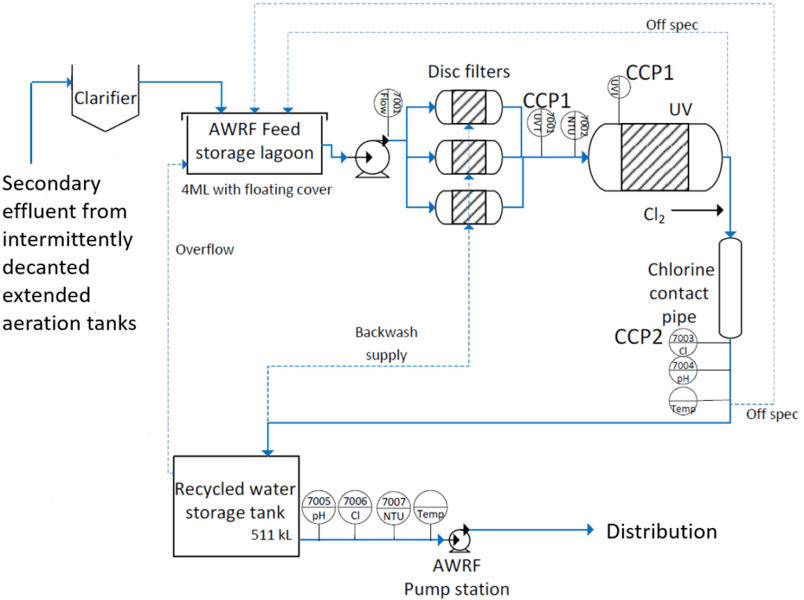 Figure 5 AWRF treatment flow diagram
Figure 5 AWRF treatment flow diagram
The water quality targets are achieved with a low energy footprint that is 31.5% smaller than the concept design that featured membrane ultrafiltration, and will emit 3150 tonnes less GHG emissions over its lifetime. The omission of membranes also avoids almost 3 tonnes per year of cleaning-in-place chemicals such as acid and chlorine. AWRF energy demand is offset by a further 50% or more due to the solar PV system and sizing of the process components to limit operation times to solar production and the nightime off-peak period.
Through a process of optioneering - assessing the performance of alternative designs to better meet project objectives and overcome constaints related to the infrastructure location, operations and sustainability - the IWCM ring main distribution concept morphed into a rising main divided into two pressure zones. This is estimated to reduce the energy intensity of the system by around 33%. Operation of the RWRM to date has shown no reduction in service levels at sites that were previously connected to the potable supply. Target pressures have been achieved and increases to irrigation demand can be accommodated. Anticipated pressure shortfalls at two end user sites have been overcome thorugh the installation of site booster pumps, which have been tested to confirm that the sprinkler systems achieve the required coverage.
Figure 6 provides a sample of further sustainability benefits arising from the delivery and operation of the RWS. These and other outcomes such as the construction of an indigenous town entrance garden and a Wiradjuri cultural garden, have been achieved within the original project budget that made no explicit allowance for sustainability measures. Overall, costs associated with sustainability iniatives and rating activities are forecast to amount to 2.5% of the total project budget.
Irrigation schedules based on modelled demand were developed to satisfy irrigation demand but ensure that the water is delivered at the right time to avoid public exposure (between 10 pm and 7 am) at a rate that will not result in ponding, runoff, or accumulation of salt in the root zone. The bore top-up has been integrated into raw water supply to WTP with control philosophy developed to ensure that does not impact potable supply to the town or PSC's largest customer, the Northparkes Mine.
To build the EUCS, PSC chose to embrace Internet of Things (IoT) technology to reduce capital and operational costs. This involved deploying custom-built solar-powered dataloggers that could convey data via low powered wide area networks to be stored, analysed and presented on a bespoke web application. Specialised technology integration software was used to link the data from the IoT devices and the AWRF SCADA system with the Microsoft Azure cloud platform. To realise the control aspect of the system, dataloggers attached to ‘smart’ end user water meters were configured to use the Telstra CAT M1 network, which allowed them to reliably receive control signals initiated from the web application. The loggers were also fitted with capacitors that could fire an DC pulse sufficient to activate 12V latching solenoids which in turn opened or closed pressure sustaining valves positioned in line with the water meter. Monitoring of weather and on-site tank levels is performed using loggers communicating on Council’s own LoRaWAN network.
The EUCS now provides Council and end users with an intuitive user interface that enables:
- Setting water allocations based on different demand scenarios and programming irrigation schedules to suit (Council only);
- Assessing the need and appropriateness of watering end user sites;
- Tracking sprinkler system performance;
- Pinpointing out-of-schedule or excess irrigation;
- Identification of leaks in irrigation reticulation;
- Alerting users to water quality issues.
Through its ability to restrict supply to end user sites, the EUCS also protects the Scheme from excessive demand, and end users and the public from exposure risks associated with water quality incidents and irrigation occurring out-of-hours or during unfavourable weather conditions.
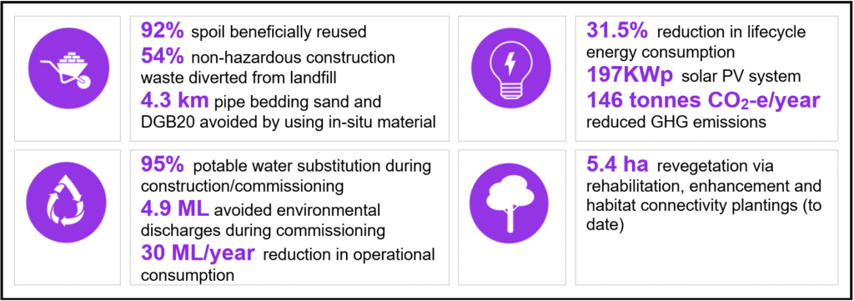 Figure 6 Selection of sustainability outcomes from the Parkes RWS
Figure 6 Selection of sustainability outcomes from the Parkes RWS
Lastly, community surveys have twice shown a high level of support for the Scheme. The most recent survey, undertaken in September 2019 with a sample size of 170 (>1% of the population in Parkes) showed over 92 per cent of respondents expressing support, and 6 per cent neutral. Only one respondent expressed disapproval. Responses to social media posts were also overwhelmingly positive through the course of project delivery.
Lessons learnt and critical success factors
The successes of the Scheme delivery have arisen from a combination of tight but adaptive project management, effective collaboration, astute technical oversight, a broad, technically-sound and practical sustainability agenda and team dedication. Various difficulties were encountered along the way, some which have produced valuable learnings, not only for Council but also regional water utilies and the industry more broadly.
While the sutainability accreditation process has been an effective driver for sustainability outcomes, it has also been resource- and time-intensive, and challenging for PSC to balance against competing capital project and operational demands. It has also been somewhat constrained by a lack of maturity in the regional supply chain, and at times inhibited by a lack of willingness and/or capability on the part of contractors to commit to and follow through with sustainability initiatives, records and documentation.
End user connections have proven more difficult than anticipated. Every site and connection had unique characteristics and features from which arose unknowns and design uncertainties such as undocumented services, missing or outdated plans, particular operational needs/expectations, and lack of experience with the technology being installed. These issues caused numerous disruptions/delays and in some instances necessitated re-work. In retrospect, the project would have benefited from (even) more thorough information gathering and design prior to tendering for the works, ideally with guidance from experienced practitioners. Nevertheless, these obstances were overcome through close, respectful collaboration with the various stakeholders. When working with contractors and suppliers, technical and scheduling discussions were accompanied by open, civil commercial dialogue so as to ensure fair apportioning of financial impacts and maintain a clear pathway to practical completion.
Lastly, the project is on the way to demonstrating that IoT technology can offer a viable alternative to SCADA for non-critical system controls. However, the control aspect of IoT is still in its infancy, at least for infrastructure applications, and would benefit from continued development within the water industry.
Closing Remarks
The Parkes Recycled Water Scheme represents an example of community-oriented infrastructure that has both a sustainable premise and has produced strong sustainability outcomes. It has been exceptionally well-received by the Parkes community and promises to deliver long-term social, environmental and economic benefits. However while it is well-positioned to receive accreditation through ISCA, further value could be gained by drawing on the many learnings from the project, both negative and positive, to inform development of sustainability guidance and/or a framework specifically tailored to water infrastructure and servicing. Such a framework could assist in sustainability goal setting and prioritisation, and could extend to providing guidance on enabling sustainability in operation and administration.
Following more than a decade of planning and over 3 years of project delivery, the Parkes RWS is in the ground and operational. However there remains a way to go before the project can truly be considered a success, simply because introducing an entirely new water supply scheme amounts to a step change for both the water utility and the community. Such a transition brings with it a new suite of risks, regulations, levels of service and operational challenges to familiarise with and eventually normalise within day-to-day business operation. Moreover, Phase 3 of the Scheme is yet to be initiated. And so there remains more to be told of the story of the Parkes Recycled Water Scheme.
ACKNOWLEDGEMENTS
The authors wish to pay tribute to the vision and commitment shown by the Councillors and staff at Parkes Shire Council in initiating and seeing through the Parkes RWS project, which was part funded by the Australian Government through the National Stronger Regions Fund. We would also like to acknowledge the project delivery tirelessly overseen by the PSC Project Management Office and the contributions made by our various project partners including (but not limited to) Atom Consulting, The Environmental Factor, Circulr, John Holland, Hunter H2O, GHD, Leed Engineering, FB Contracting, Indicium Dynamics, 360 Engineering, Safegroup, Bermad Water Technologies, Aquagreen Project Solutions, Sala4D, Aecom, Steve Magill Earthmoving, K&H Geotechnical Services and Derrick Hoe Excavations. Lastly the authors would like to acknowledge the Parkes community, without the support of which the project could not have been a success.
About the authors
Julian Fyfe | Julian Fyfe was the Infrastructure Technical Manager at Parkes Shire Council, taking the technical and sustainability lead on the delivery and operationalisation of the Parkes Recycled Water Scheme. Drawing on experience in academia, consulting and local government, he is committed to enabling the transition to a sustainable future through planning, development and delivery of innovative, community-focused water servicing. He is now the Programme Manager Sustainable Water Supply with Wellington Water in New Zealand.
Claire Li | Claire is a process engineer and a young water professional with a passion for people, safety and sustainability. She worked on the Parkes Recycled Water Scheme, providing technical support to the project delivery team. She is currently working as a planning engineer in regional Victoria, assisting in the transition to sustainability communities via the planning of potable and alternative water supply projects.
Gabriel Oliveira | Gabriel is a chemical engineer currently working as a Process Technician with Ixom. In his prior role with Parkes Shire Council he provided technical and operational support to the Parkes Recycled Water Scheme project, playing a key role in facilitating collaboration between the project management team, Council stakeholders and project partners.
Hassanian Al Kabanchi | Hassi is a graduate chemical engineer with a strong interest in the water industry and IoT systems. As a young professional, he is passionate about water conservation and the sustainable sourcing of water resources. Hassi provided technical support for the commissioning and operationalisation of the Parkes Recycled Water Scheme.
Sloan Trad | Sloan Trad is an independent consultant who only works on projects that strategise today for a future worth living. He has 5 years of experience with integrating sustainability into infrastructure projects including leading climate change risk assessments, establishing sustainability frameworks, managing sustainability rating schemes, and engaging the Aboriginal community.
Andrew Francis | Andrew Francis is the Director of Infrastructure at Parkes Shire Council, responsible for Council’s Water, Sewer, Recycled Water and Stormwater services, and management of the natural environment including noxious weeds, sustainability and emergency management. He was the project superintendent on the Parkes Recycled Water Scheme construction packages. Andrew is chair of the CENTROC Water Utilities Alliance, has served as Secretary and Chair of the Central West IPWEA Group, and is an active member of Engineers Australia, the Australian Water Association and the Local Government Engineers Association.
References
AEC Group, 2014. Economic Appraisal of the Parkes Wastewater Treatment Plant – Recycled Water Facility (No. 1.3). Prepared by AEG Group for Parkes Shire Council.
Contos, A., Wilson, A., 2017. Parkes AWRF Water Quality Risk Assessment Workshop Output Paper. Prepared by Atom Consulting for Parkes Shire Council, St Ives.
EPHC, NRMMC, AHMC, 2006. Australian guidelines for water recycling : managing health and environmental risks (phase 1), National water quality management strategy. Environment Protection and Heritage Council, the Natural Resource Management Ministerial Council and the Australian Health Ministers’ Conference, Canberra, ACT.
Fyfe, J., Francis, A., Von Rabenau, D., Llivas, J., 2018. Sustainability Accreditation of the Parkes Integrated Water Infrastructure Renewal Project. Presented at the Sustainability in Public Works Conference, IPWEA, Brighton le Sands, Sydney.
Fyfe, J., Turner, A., 2014. A Recycled Water Scheme for Parkes (Discussion paper). Prepared by the Institute for Sustainable Futures for Parkes Shire Council, Sydney.
Harrison, M., 2017, Recycle Water Scheme: Supply Management and Distribution. Honours thesis, School of Chemical and Biomolecular Engineering, University of Sydney.
Gea Environmental, 2017. Review of Environmental Factors Parkes Sewage Treatment Plant Addendum 5 – Advanced Water Recycling Facility. Prepared for Parkes Shire Council by GEA Environmental, Brisbane.
ISF, 2013a. Making better recycled water investment decisions: Shifts happen. Prepared for the Australian Water Recycling Centre of Excellence by the Institute for Sustainable Futures, Sydney.
ISF, 2013b. Demand forecasting: a risky business. Prepared for the Australian Water Recycling Centre of Excellence by the Institute for Sustainable Futures, Sydney.
ISF, 2013c. Matching treatment to risk. Prepared for the Australian Water Recycling Centre of Excellence by the Institute for Sustainable Futures, Sydney.
ISF, 2013d. Saving water and spending energy? Prepared for the Australian Water Recycling Centre of Excellence by the Institute for Sustainable Futures, Sydney.
JWP, 2005. Parkes Integrated Water Cycle Management Plan. Prepared for Parkes Shire Council by JWP, Sydney, NSW.
MWH, 2012. Parkes Shire Council IWCM review. Prepared for Centroc by MWH, Sydney, NSW.
NSW Office of Water, 2015. NSW Guidelines for Recycled Water Management Systems.
Parsons, L., Crawford, N., Contos, A., 2019. Recycled Water Scheme Phase 2 Risk Assessment Output Paper. Prepared by Atom Consulting for Parkes Shire Council, St Ives.
PSC, 2017. Parkes Shire 2030+ Community Strategic Plan.
PSC, 2017a. Integrated Water Cycle Management Strategy: Part B IWCM Strategy. Parkes Shire Council, Parkes, NSW.
PSC, 2017b. Parkes Recycled Water Scheme Stakeholder Engagement Strategy. Parkes Shire Council, Parkes, NSW.
PSC, 2017c. Parkes Recycled Water Scheme Strategy. Parkes Shire Council, Parkes, NSW.
Standards Australia, 2013. AS 5334-2013 Climate change adaptation for settlements and infrastructure - A risk based approach.
The Environmental Factor, 2018. Recycled Water Scheme – Phase 2: Recycled Water Rising Main Review of Environmental Factors. Parkes Shire Council, Bathurst.

